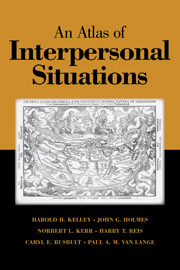Book contents
- Frontmatter
- Contents
- Preface
- PART ONE INTRODUCTION AND THEORY
- 1 Interpersonal Situations: The Context of Social Behavior
- 2 Outcome Interdependence
- 3 Interaction Conditions and Person Factors
- 4 Exploring the Geography of the Outcome Patterns
- PART TWO THE SITUATIONS
- Single-Component Patterns
- Two- and Three-Component Patterns
- Time-Extended Patterns
- Incomplete Information Situations
- N-Person Situations
- Movement from One Situation to Another
- PART THREE EPILOGUE
- References
- Author Index
- Subject Index
4 - Exploring the Geography of the Outcome Patterns
Published online by Cambridge University Press: 21 October 2009
- Frontmatter
- Contents
- Preface
- PART ONE INTRODUCTION AND THEORY
- 1 Interpersonal Situations: The Context of Social Behavior
- 2 Outcome Interdependence
- 3 Interaction Conditions and Person Factors
- 4 Exploring the Geography of the Outcome Patterns
- PART TWO THE SITUATIONS
- Single-Component Patterns
- Two- and Three-Component Patterns
- Time-Extended Patterns
- Incomplete Information Situations
- N-Person Situations
- Movement from One Situation to Another
- PART THREE EPILOGUE
- References
- Author Index
- Subject Index
Summary
In this chapter, we examine in some detail the 2 × 2 outcome matrices which, as explained in chapter 2, define the problems that interdependent persons may encounter. This requires further explanation of how the basic patterns of interdependence (see Table 2.7) may be combined to produce more complex patterns. Our general point is that many complex situations can be understood more clearly when considered as a combination of certain basic elements. We then take a closer look at the three dimensions of symmetric interdependence shown in chapter 2 (Figure 2.2) and see how various common patterns are distributed through those dimensions. The distribution enables us to gain further understanding of each situation by examining its location relative to other situations. For example, as will be explained in this chapter, the distribution of the situations has implications for the developmental course of a dyadic relationship as, through changes in the individuals and the problems they encounter, a pair moves from one kind of situation to another. Readers who are less interested in the full implications of our combinatorial system may prefer to skip this chapter and go directly to the following “Introduction to the Entries” and to the entries themselves.
Exploring the Possible 2 × 2 Matrices by Combining the Basic Components
All possible patterns of 2 × 2 interdependence can be constructed by combining the patterns of control represented in Table 2.7: Bilateral Actor Control (BAC), Mutual Partner Control (MPC), and Corresponding or Conflicting Mutual Joint Control (MJC).
Information
- Type
- Chapter
- Information
- An Atlas of Interpersonal Situations , pp. 82 - 110Publisher: Cambridge University PressPrint publication year: 2003
